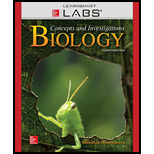
Concept explainers
You discover that a 24,000-year-old fossil has one fourth the concentration of a radioactive isotope compared to a living organism.
What is the half-life of this isotope?
- a. 3000 years
- b. 6000 years
- c. 8000 years
- d. 12,000 years
Introduction:
The radioactive isotopes are used for the determining the age of fossils. The half-life of the radioactive isotope is used and the age of the fossil is calculated. The technique of using radioactive isotopes in determining the age of fossils is called radioactive dating.
Answer to Problem 1MCQ
Correct answer:
The half-life of the isotope is
Explanation of Solution
Reason for the correct statement:
The formula for the calculation of the half-life of an isotope where A is the remaining amount of the radioactive isotope,
Here, the concentration of the radioactive isotope is one-fourth that of the original matter. So, the A is equal to one fourth of
Option d. is given as “
As, “the half-life for the radioactive isotope is
Hence, the option d. is correct.
Reasons for the incorrect statements:
Option a. is given as “
The half-life of the radioactive isotope will be
Option b. is given as “
The half-life of the radioactive isotope will be
Option c. is given as “
The half-life of the radioactive isotope will be
Hence, options a., b., and c. are incorrect.
The half-life for the radioactive isotope is
Want to see more full solutions like this?
Chapter 13 Solutions
Connect With Learnsmart Labs Access Card For Biology: Concepts And Investigations
Additional Science Textbook Solutions
Essentials of Human Anatomy & Physiology (11th Edition)
Essentials of Genetics (9th Edition) - Standalone book
Genetics: From Genes to Genomes
Human Physiology
Anatomy & Physiology (6th Edition)
- Which is true concerning how fossils are used as evidence? A. Fossils cannot be compared to one another but can be compared to living organisms. B. Fossils can be compared to one another but not to living organisms. C. Fossils cannot be compared to one another or to living organisms. D. Fossils can be compared to one another and to living organisms.arrow_forwardAbout when did the common ancestor of chimpanzees, humans, gorillas, and orangutans last exist? a. Between 5 and 8 million years ago b. Less than 5 million years ago c. More than 15 million years ago d. Between 10 and 15 million years ago e. Between 8 and 10 million years agoarrow_forwardThe genus Homo dates back to about____. a. 3.9 million years ago b. 1.8 million years ago c. 250,000 years ago d. 2.8 million years agoarrow_forward
- Modern humans first entered the Americas about____ years ago, and Australia and New Guinea by at least____ years ago. a. 15,000; 200,000 b. 50,000; 20,000 c. 100,000; 200,000 d. 20,000; 50,000arrow_forwardWhich mechanism of fossil formation created a replica of an organism's original form? a natural cast b amber-preserved c permineralization d trace fossilarrow_forwardWhich evolutionary pattern is represented by the similarities between these two organisms that live on separate continents? a.) coevolution b.) convergent evolution c.) directional evolution d.) divergent evolutionarrow_forward
- The first forms of life on Earth were ________. a. plants b. microorganisms c. birds d. dinosaursarrow_forwardIn which type of rock are you most likely to find a fossil? a. basalt, a dark, fine-grained volcanic rock b. limestone, composed of sedimented calcium carbonate c. slate, a volcanically melted and cooled shale d. granite, which forms by crystallization of magma cooling below Earth’s surfacearrow_forwardWhich of these steps probably occurred first in the chemical andbiological evolution of life?a. The cell membrane of a protobiont formed.b. The first organic molecules formed.c. The original genetic material was RNA.d. Simple organic monomers formed from inorganic materials.arrow_forward
- One type of fish fossil is found only in a rock layer near the bottom of a canyon, while a different kind of fish fossil is found only in a rock layer 4,000 feet higher, near the top of the canyon. Which statement would a scientist most likely offer to explain this situation? A.) The fish in the lower layer lived in the deep sea. While the other fish lived in shallow water. B.) The fish in the upper layer lived a healthier life than the other fish. C.) The rock in the lower layer is denser than the rock in the upper layer D.) The rock in the upper layer must have formed in freshwater E.) The fish in the upper layer lived more recently than the other fish. The Geologic Time Scale is a systematic chronological dating process that relates geological strata to time. This methodology is commonly used be geologists, paleontologists, and other Earth scientists to describe the timing and relationships of events that once occurred in history. Which of the following statements can be…arrow_forwardwhich term describes any ancient remains, impressions, or traces of an organism or traces of its activity that have been preserved in rocks or other mineral deposits in Earth’s crust? a. analogous feature b. homologous feature c. mutation d. fossilarrow_forwardWhat is potentially the first example of art in the world? A. A cave painting of stars at night B. A cave painting of a rhino C. Handprints and footprints made by Denisovan children D. A cave painting of other homininsarrow_forward

 Concepts of BiologyBiologyISBN:9781938168116Author:Samantha Fowler, Rebecca Roush, James WisePublisher:OpenStax College
Concepts of BiologyBiologyISBN:9781938168116Author:Samantha Fowler, Rebecca Roush, James WisePublisher:OpenStax College

